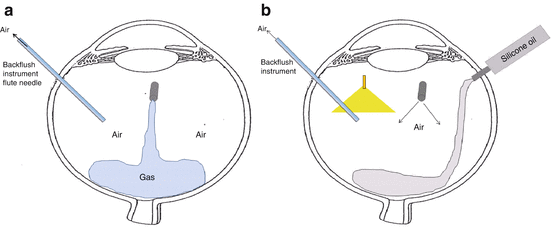and Mitrofanis Pavlidis2
(1)
Department of Ophthalmology, Uppsala University Hospital, Uppsala, Sweden
(2)
Augencentrum Köln, Cologne, Germany
6.1 Basics of Postoperative Tamponades
Question
What do intraocular gases and fluids have in common?
Answer
6.1.1 Gases and Liquids
In posterior segment surgery, various gases and liquids are used. It is therefore important to understand their characteristics and abilities. Four different intraocular gases are commonly used: air, sulphur hexafluoride (SF6), perfluoroethane (C2F6) and perfluoropropane (C3F8). In the vitreous cavity, these gases are colourless, odourless and inert. When injected into the vitreous cavity, air does not expand, whereas pure SF6, C2F6 and C3F8 gases do. All gases are, however, used in a non-expanding concentration (see Table 6.1).
Table 6.1
Our normogram for tamponades in regard to the specific pathology. We use rarely 5000 cSt silicone oil and C3F8
Macular hole | Retinal detachment | Diabetic retinopathy | |
|---|---|---|---|
Postoperative tamponade | SF6; in case of long-standing hole and no posture possible: 1000 cSt silicone oil | SF6, C2F6, 1000 cSt silicone oil; in case of inferior detachment: Densiron 68 | Mild PDR: Air or SF6, difficult PDR, 1000 cSt silicone oil |
Duration of tamponade | Silicone oil: 4–6 weeks | Silicone oil: 6 weeks; Densiron 68: 6 weeks | Silicone oil: 2–3 months |
Postoperative posture | 5 days on the opposite cheek | 7 days depending on position of retinal break | No posture |
Gases are temporary tamponades and are absorbed over several days (air) to months (C3F8). Air < SF6 < C2F6 < C3F8; see Table 6.1. Silicone oil tamponades, however, are permanent tamponades and are usually removed between 6 weeks and 6 months after the initial surgery. Perfluorocarbon (PFCL) is a temporary, preoperative tamponade used especially for detachment surgery.
Remark
If the term “water-filled eye” is used in this book, it means an eye filled with “balanced salt solution (BSS)”. The BSS will be replaced postoperatively by aqueous humour.
In order to understand the function of the gases and liquids, one needs to know their physiologic abilities.
6.1.2 Physiologic Characteristics of Gases and Liquids: Specific Gravity
Substances with a specific gravity (SG) of 1 are neutrally buoyant; those with SG greater than 1 are denser than water and will sink in it; and those with an SG of less than 1 are less dense than water and so will float. The following figure (see Table 6.2) gives the location of the fluids and gases depending on their relative weight within the vitreous cavity. Perfluorocarbon (PFCL) is the heaviest liquid and is always located on the bottom of the eye. Heavy silicone oils (Densiron 68®, Oxane Hd®) are heavier than water and tamponade therefore the inferior circumference. Conventional silicone oils are lighter than water and tamponade the superior circumference. The lightest tamponades used are gases; they are always located anteriorly.
Table 6.2
Relative location of liquids, oils and gases in the vitreous cavity
Air/gas; SG = 0.0012 | Vitreous space SG = 1 |
Conventional silicone oils; SG = 0.97 | |
Water; SG = 1 | |
Heavy silicone oils; SG = 1.06 | |
Perfluorocarbon; SG = 1.75 |
In the eye, several gases or liquids may be present at the same time. In this context, the term phase is important. Phase is with regard to physical properties, a spatially homogeneous field. One uses the term, for example, of a gaseous phase or liquid phase. A gas or liquid “bubble” refers to the spherical shape. Another important term is the meniscus: It refers to the curved surface of a liquid.
6.1.3 Surface Tension Pressure
The high surface tension between gas and fluid enables formation of an effective seal around a retinal break, thus preventing the flow of fluid into the subretinal space. The remaining subretinal fluid is absorbed by the pigment epithelium and the retina reattaches. The surface tension pressure of the gas/water interface is the greatest and therefore is the most effective in closing retinal breaks (70 mN/N). Because the specific gravity of any gas is lower than that of water, the intraocular gas bubble has buoyancy that presses the retina against the RPE, and this effect is greatest at the apex of the gas or fluid bubble. Buoyancy forces can be directed by positioning of the patient’s head so that the retinal break is placed at the apex of the bubble. Within 5 days, chorioretinal adhesions created by laser photocoagulation or cryotherapy are established. Less effective are silicone oils because the surface tension pressure of silicone oil/water is only 50 mN/N.
6.1.4 Expanding Gases
SF6, C2F6 and C3F8 are expanding gases as dissolved nitrogen diffuses along the concentration gradient from the blood into the gas bubble and accumulates here. The postoperative extension may lead to strong increases in intraocular pressure when the gases are injected undiluted into the eye. To avoid this intraocular pressure rise, expanding gases are used in a concentration in which they do not expand. The non-expanding concentration of SF6 is 20 %, of C2F6 15 % and of C3F8 14 % (see Table 6.1). Patients with a gas-filled eye should not undergo anaesthesia with nitrous oxide, as it diffuses into gas-filled cavities and leads to an increase of volume. In addition, any air travel or trips to locations at greater heights (e.g. patients living in mountainous areas) are strictly prohibited.
Important
These restrictions also apply for air. Air is a gas and expands also. Patients with an air tamponade are not allowed to fly because air expands with increasing altitude. A plane flying at a height of 10,000 m above sea level has an air cabin pressure of 2400 m.
Stay updated, free articles. Join our Telegram channel

Full access? Get Clinical Tree



